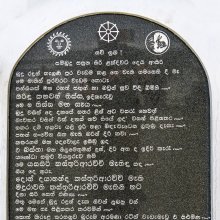Seya, Sheya: 6 definitions
Introduction:
Seya means something in Hinduism, Sanskrit, the history of ancient India. If you want to know the exact meaning, history, etymology or English translation of this term then check out the descriptions on this page. Add your comment or reference to a book if you want to contribute to this summary article.
Images (photo gallery)
In Hinduism
Purana and Itihasa (epic history)
Source: archive.org: Puranic EncyclopediaSeya (सेय).—One of Viśvāmitra’s sons who were expounders of the Vedas. (Mahābhārata Anuśāsana Parva, Chapter 4, Stanza 58).

The Purana (पुराण, purāṇas) refers to Sanskrit literature preserving ancient India’s vast cultural history, including historical legends, religious ceremonies, various arts and sciences. The eighteen mahapuranas total over 400,000 shlokas (metrical couplets) and date to at least several centuries BCE.
India history and geography
Source: Wikipedia: India HistorySeya is synonymous with Stupa: an outstanding type of architectural creation of ancient Sri Lanka. Under the influence of Buddhism, there were several changes in the field of architecture in Sri Lanka. The stupa commands a prominent place among these changes.

The history of India traces the identification of countries, villages, towns and other regions of India, as well as mythology, zoology, royal dynasties, rulers, tribes, local festivities and traditions and regional languages. Ancient India enjoyed religious freedom and encourages the path of Dharma, a concept common to Buddhism, Hinduism, and Jainism.
Languages of India and abroad
Sanskrit dictionary
Source: Cologne Digital Sanskrit Dictionaries: Monier-Williams Sanskrit-English Dictionary1) Śeya (शेय):—n. [impersonal or used impersonally] ([from] √1. śī) it is to be lain or slept, [Pāṇini 7-4, 22 [Scholiast or Commentator]]
2) Seya (सेय):—1. seya n. ([from] √san) obtaining (See śata-s).
3) 2. seya mfn. ([from] √so). See ava-seya.
4) [from so] a See sub voce
Source: DDSA: Paia-sadda-mahannavo; a comprehensive Prakrit Hindi dictionary (S)Seya (सेय) in the Sanskrit language is related to the Prakrit word: Sea.
[Sanskrit to German]
Sanskrit, also spelled संस्कृतम् (saṃskṛtam), is an ancient language of India commonly seen as the grandmother of the Indo-European language family (even English!). Closely allied with Prakrit and Pali, Sanskrit is more exhaustive in both grammar and terms and has the most extensive collection of literature in the world, greatly surpassing its sister-languages Greek and Latin.
Kannada-English dictionary
Source: Alar: Kannada-English corpusSēya (ಸೇಯ):—[noun] the quality of being long; longness.
Kannada is a Dravidian language (as opposed to the Indo-European language family) mainly spoken in the southwestern region of India.
See also (Relevant definitions)
Starts with (+8): Ceya, Ceya-nirkaruttan, Ceya-pattuvinai, Ceya-patu-porul-kunratavinai, Ceya-patu-porul-kunriyavinai, Ceya-patuporul, Ceyaceti, Ceyacurai, Ceyai, Ceyakosham, Ceyal, Ceyalai, Ceyalali, Ceyalaravu, Ceyalaru, Ceyalmal, Ceyamankalam, Ceyan, Ceyanir, Ceyapari.
Query error!
Full-text (+35): Kalasheya, Avaseya, Ceya, Shataseya, Varanaseya, Ceyaceti, Jeyam, Seyya, Anustarana, Ceyativacam, Ceyakosham, Ceyavanai, Ceyam, Ceya-patu-porul-kunratavinai, Ceyamankalam, Ceyanir, Ceya-nirkaruttan, Mantalaceyam, Verri, Ceyacurai.
Relevant text
Search found 60 books and stories containing Seya, Sheya, Śeya, Sēya; (plurals include: Seyas, Sheyas, Śeyas, Sēyas). You can also click to the full overview containing English textual excerpts. Below are direct links for the most relevant articles:
Notices of Sanskrit Manuscripts (by Rajendralala Mitra)
Sanskrit sources of Kerala history (by Suma Parappattoli)
2. Kerala-kshetra-mahatmyam < [Chapter 2 - Historical details from Mahatmyas and Prashastis]
Later Chola Temples (by S. R. Balasubrahmanyam)
Temples in Allur < [Chapter XII - Temples of Kulottunga III’s Time]
Appendix: Nanadesis < [Chapter XVI - Temples of Rajendra III’s Time]
Appendix: Temples or parts thereof built and miscellaneous facts < [Chapter II - Temples of Kulottunga I’s Time]
Vivekachudamani (by Shankara)
Bhakti-rasamrta-sindhu (by Śrīla Rūpa Gosvāmī)
Verse 2.1.372 < [Part 1 - Ecstatic Excitants (vibhāva)]
Verse 2.5.11 < [Part 5 - Permanent Ecstatic Mood (sthāyī-bhāva)]
Verse 4.7.9 < [Part 7 - Ghastliness (vībhatsa-rasa)]
Pratyabhijna and Shankara’s Advaita (comparative study) (by Ranjni M.)
8. Prasthānatraya in Vedānta < [Chapter 2 - Historical and Cultural background of Pratyabhijñā and Advaita Vedānta]
5.5. States of Experience < [Chapter 3 - The nature of Universe and Individual Self in Pratybhijñā and Advaita]
